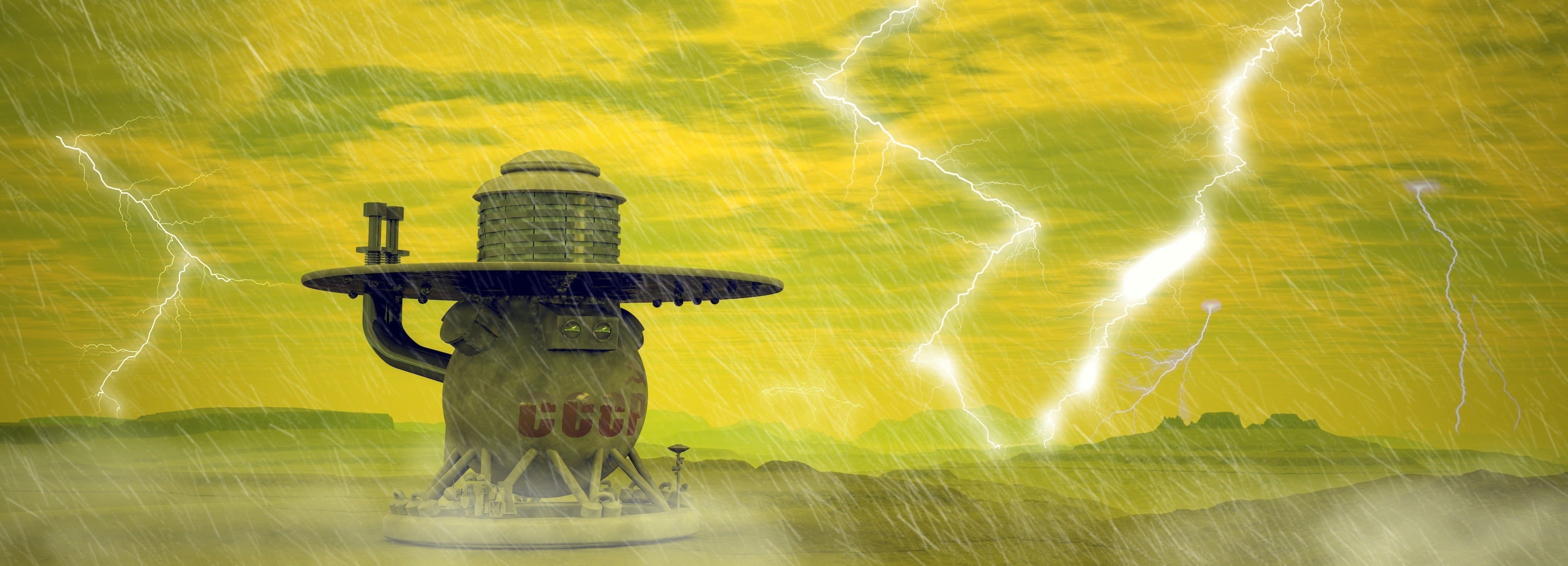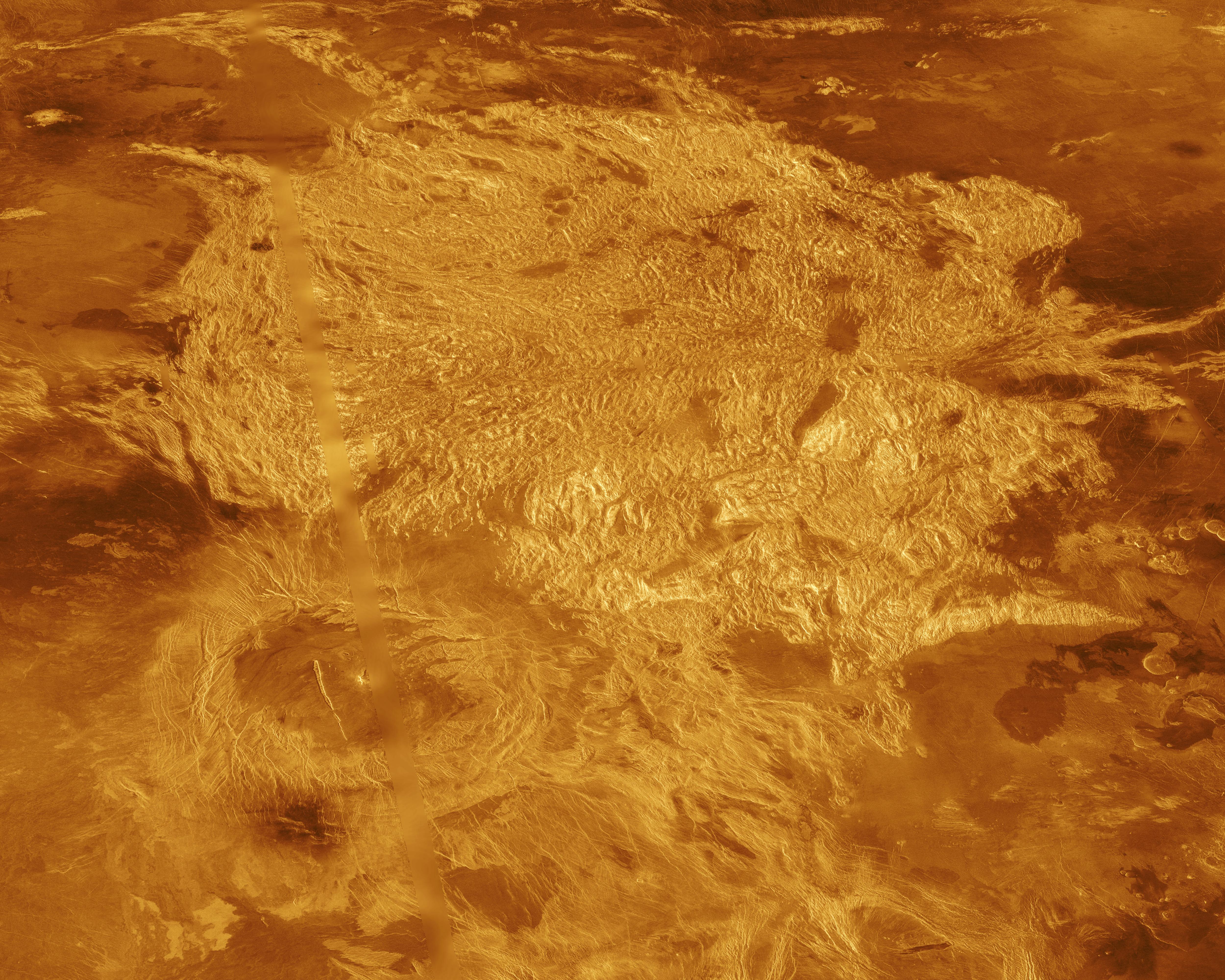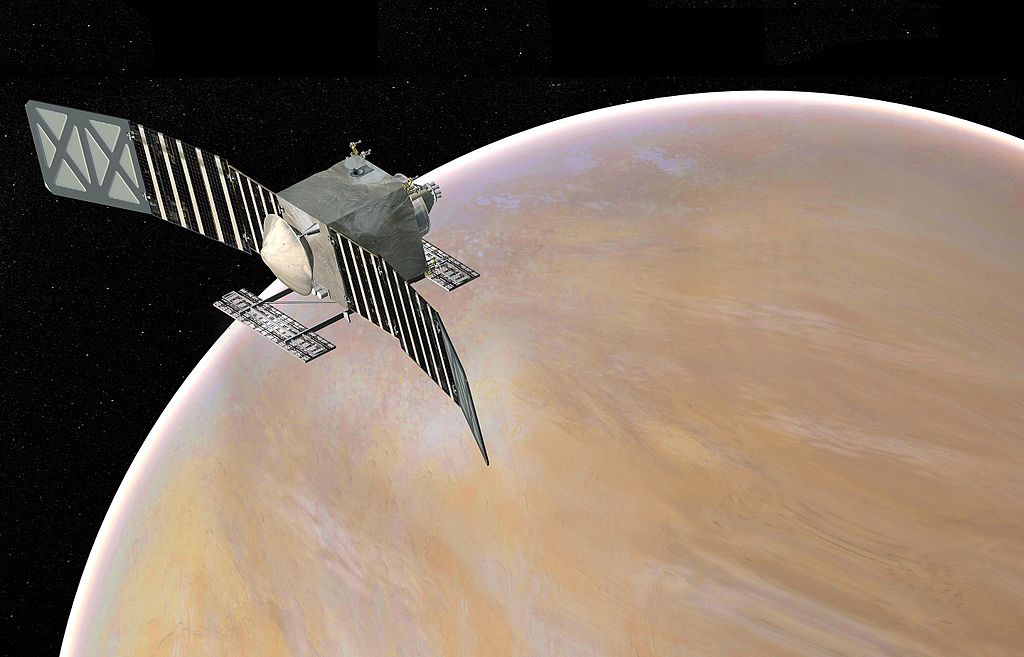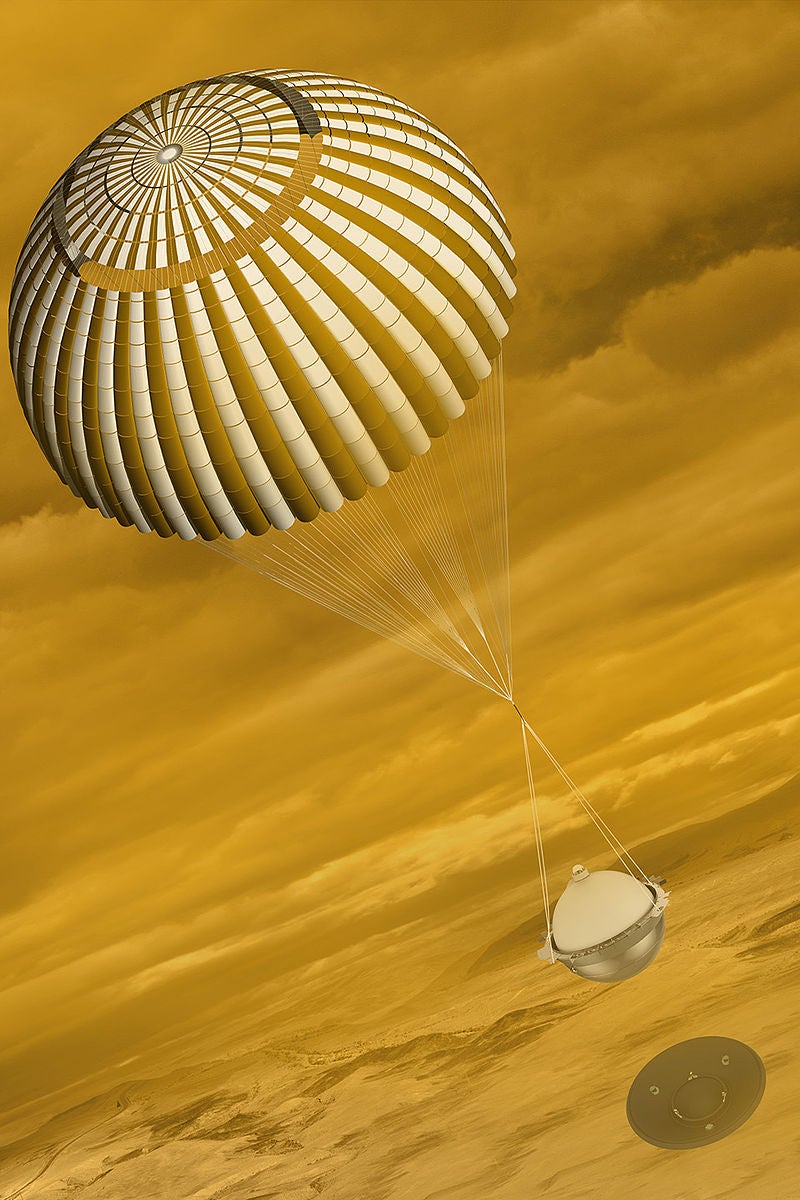*Editor's Note (6/2/2021): Shortly after this article was published, NASA announced its decision to fly not one but both proposed Venus missions, VERITAS and DAVINCI+, beginning a new era of exploration for Earth's estranged sister world.
Like many kids, Sue Smrekar dreamed that she would one day voyage into space. But instead of becoming an astronaut, she ended up as a planetary geophysicist at NASA’s Jet Propulsion Laboratory, where she worked on robotic explorers of other worlds. In some sense, her interplanetary destiny seemed preordained even before she was born: her father hails from a rural community in Pennsylvania named Venus.
Fittingly, the very first mission Smrekar worked on was NASA’s ambitious (and wildly successful) Venus orbiter Magellan. Launched in 1989, Magellan was equipped with a sophisticated radar system, one that peered beneath the planet’s omnipresent clouds to map its entire surface for the first time. Smrekar recalls watching the initial radar images come in, revealing a bizarre world covered in few craters, a surfeit of volcanoes and rolling plains of frozen lava.
Magellan’s explorations ended in 1994 when, its objectives met and its solar-power panels degraded, the orbiter was sent plunging into Venus’s atmosphere. Although it raised a plethora of tantalizing questions about the planet’s past and present, Magellan marked the last time NASA sent a dedicated mission to Venus. Just as Smrekar and other Venus-minded researchers were beginning to grapple with the planet’s mysteries, as unveiled by Magellan, sensational claims of life on Mars captured the public imagination. Today, a quarter-century later, most of the global planetary-science community still remains wrapped up in the so-far-fruitless search for Martian life. All the while, Venus—an acidic, superhot, arid and presumably lifeless wasteland—has languished in the shadows.

“Currently, the Venus community is a bit like Boston Red Sox fans prior to 2004, who lived under the ‘curse of the Bambino’ for endless decades,” Smrekar says, referring to the baseball team’s 86-year championship drought. Yet like some of her steadfast colleagues, she has remained motivated through decades of disappointment by one of the most compelling unanswered questions in planetary science: What transformed Venus—a near twin of Earth in size and composition—into such an unearthly and downright apocalyptic state? Why did these two similar, adjacent planets have such staggeringly divergent stories?
Perhaps the time for answers has finally come. NASA is about to pick which interplanetary mission—or pair of missions—it will send into space next. The space agency has four options: one would visit a moon of Neptune, another would rendezvous with a Jovian moon, and two would return to Venus. Smrekar is the principal investigator of one of those Venusian hopefuls, and the entire community is holding its breath alongside her.
“We are all desperately hoping the ‘Venus curse’ will be lifted,” she says. Will it?
Turning Their Back on the Devil
Although NASA got there first with the Mariner 2 flyby in 1962, for much of the cold war, Venus really belonged to the Soviet Union. Its Venera mission program, consisting of a series of mostly landers flung at Earth’s neighbor, first found success in 1967—when Venera 4 entered and transmitted data from the Venusian atmosphere, revealing hints of the planet’s horrors to stunned scientists who had expected more clement conditions.
Multiple successful Venera landings helped nudge NASA back to Venus in 1978 with the launch of the Pioneer mission, an orbiter-probe combo. After the Soviets flew two showy balloon-lofted probes through the planet’s atmosphere, NASA upped the ante with the radar-wielding Magellan orbiter. With each subsequent mission, it became clearer this exercise in interplanetary one-upmanship was over a world nightmarishly ill-suited for future human exploration.
Venus’s thick atmosphere, comprised of around 95 percent carbon dioxide, is suffocating. Its cloud layers are packed with sulfuric acid—enough to chew through skin, bone and metal in moments. If you stood on the surface, you would escape the corrosive rain but only because rain down there is impossible: the ground bakes at more than 900 degrees Fahrenheit, hot enough to broil any astronaut or robot that dared to venture on it. If you were miraculously heat-resistant, you would still have to contend with a surface pressure that is at least 92 times of that on Earth, making the experience like being a mile or more underwater. No matter which part of the planet you visited, you would die a quick but agonizing death.

“It is the best planet, no question,” says a smirking Paul Byrne, a planetary scientist at North Carolina State University. This is an unsurprising answer from Byrne, an unabashed Venusian zealot. To him, the planet’s terrors are all part of its intrigue. Something unleashed them all long ago. Byrne wants to find out what opened Pandora’s box.
Since Magellan, Venus has been rather lonely. Europe’s Venus Express spacecraft orbited it from 2005 to 2014. Japan’s Akatsuki orbiter, which successfully entered orbit in 2015, remains there to this day, studying the Venusian atmosphere and hunting for its elusive lightning. If it were up to Byrne, there would be plenty of spacecraft flying around or landing on Venus today. Instead, he says, Venus is “a planet nobody has given a shit about for 30 years.”
The turning point arrived in 1996, when a cadre of reputable scientists published a paper announcing they had found microscopic fossils in a Martian meteorite named ALH 84001. Then president Bill Clinton gave a speech on the South Lawn of the White House about the discovery, telling the world that “the American space program will put its full intellectual power and technological prowess behind the search for further evidence of life on Mars.”
The discovery didn’t really pan out—further studies, reported with considerably less fanfare, suggested the “microfossils” could just as well have been entirely abiotic mineral formations. But the dream of finding life proved too enchanting to dismiss. Mission after mission was sent to Mars, each building off the successes of its predecessors. All of them had their own unique objectives, but most were framed by the search for water and, ultimately, microbes. Politicians and the public alike were hooked by that prospect, making it easier to justify funding and sending additional orbiters, landers and rovers to Mars. With each success, more early-career scientists were drawn in, lured by funding opportunities and fresh data to work with.
Those missions also took on their own personalities, becoming anthropomorphized in comics and obituaries. “We love the idea of all these cute robots hanging out on Mars,” says Clara Sousa-Silva, an astrochemist at the Center for Astrophysics in Cambridge, Mass. Mars has its own gargantuan PR machine, one fueled by NASA, public enthusiasts and scientists who simply wish to study the easily accessible and somewhat Earth-like planet right next door. It also benefits from the attention of a handful of publicity-hungry billionaires with grandiose ambitions (or delusions) of making it habitable. “Venus doesn’t really have [a PR campaign],” Sousa-Silva says, “probably because you can’t plant a flag on it.”

“I don’t want to say that Mars has an inviolable hold over the public,” Byrne says, “but it kind of does.” The disproportionate amount of attention Mars gets proves frustrating. Byrne regularly quips that he wishes to blow up Mars, Death-Star-at-Alderaan-style, so everyone would be forced to reconsider Venus instead. He is only half-joking.
Another problem is that Venus is a prolific destroyer of droids, whether corroding them in acid clouds or broiling and crushing them in its pressure-cooker air. Orbiters survive just fine, but studying the enigmatic surface requires excellent radar capabilities, lest the hidden realm below be completely obfuscated by the dense, overlying clouds. Conversely, with a thinner and transparent atmosphere and a cold, dry surface plagued only occasionally by global dust storms, “Mars is the ideal place to do a lot of planetary surface exploration,” Byrne says. But is Mars more valuable to science than Venus? “I do not remotely think so,” he says.
One strike against Mars is its size. At only one-sixth the volume of Earth and containing just one-tenth of our planet’s mass, it is not really “Earth-like” at all—at least, not compared with Venus, which, by those metrics, is practically our planetary twin. There is, of course, the problem of its spacecraft-slaying environment. Heat-resistant electronics that can resist the Venusian inferno are being developed for in situ exploration, but nothing yet exists that could give a surface mission more than a couple of hours of survivability. Even so, Byrne says, Venus’s bulk similarity to our own planet makes it a better pedagogical option for learning about what makes—and breaks—Earth-like worlds.
“Venus is going to be hard,” Byrne says. “But that’s not a reason not to do it.”
The Truth Seeker and the Artist
A few of NASA’s robotic space exploration endeavors are decided competitively. Typically, teams of scientists and engineers work together for several years to develop profoundly detailed proposals for missions that are then judged by senior agency officials. The cheapest of these contests are the Discovery missions, with a per-project price tag of around $600 million or less. NASA’s ruthless selection process for these missions has far-reaching ramifications: for every winner, there are dozens of losers, collectively representing a huge swath of the solar system that remains underexplored.
“Dozens of Venus missions have been proposed to NASA” since Magellan, Smrekar says. “None have been selected. Every mission competition, people think Venus’s number will surely come up.” It never has. Despite this Sisyphean malediction, with each call for new proposals, the community still tries to push its boulder back to the mountaintop.
In February 2020 NASA picked four concept studies as the latest round of Discovery finalists. Two of them were missions to Venus.
The first—the Venus Emissivity, Radio Science, InSAR, Topography, and Spectroscopy mission, or VERITAS (Latin for “truth”)—is led by Smrekar. This orbiter’s state-of-the-art radar system would generate an unprecedentedly detailed map of the planet. It would replace the relatively low-resolution cartography of Magellan with glorious 3-D topographic charts packed with detail, from individual volcanoes and their lava-licked landscapes to fault systems streaking through the land like scars.

VERITAS would also see in infrared, distinguishing specific minerals on the surface by their characteristic thermal glow and adding crucial context to what would already be an impressive survey of Venusian geology. This orbiter’s work would not just be, in a manner of speaking, skin-deep. Another of its instruments would peer into the guts of Venus, mapping the varying strength of the planet’s gravitational field to visualize the layer-cake structure of its interior. This mission, Smrekar says, would finally give scientists a high-fidelity view of Venus akin to the richly detailed data sets they have long possessed for the moon and Mars.
VERITAS may seem like a shoo-in for NASA’s next Discovery selection, but it faces steep competition from DAVINCI+ (Deep Atmosphere Venus Investigation of Noble Gases, Chemistry, and Imaging Plus). Named after the Renaissance-era master of everything, the DAVINCI+ mission is helmed by Jim Garvin, chief scientist of NASA’s Goddard Space Flight Center. Like Smrekar, he has been captivated by enigmatic planets for most of his life and self-effacingly shirks any limelight, almost to a fault: when asked to share some fun facts about himself, Garvin once said that he is “probably too boring for words.”

The same descriptor cannot be applied to his team’s mission concept, a somewhat more bombastic endeavor that would drop an American probe into the Venusian maw for the first time since 1978. It would tumble through the tempestuous atmosphere, gulping and analyzing its constituent chemicals during its intentionally deadly journey. As the clouds parted and the surface approached, it would use its cameras to take the most high-resolution images of the planet’s mountainous and geologically complex Alpha Regio region to date, while infrared detectors would parse out the terrain’s mineralogy. The probe would expire shortly after it landed but not before beaming back the game-changing data gathered during its parachute-slowed plunge.
Its descent probe may be the star of the show, but DAVINCI+ has an orbiter component, too. It would lack the radar systems that VERITAS would boast, but its cameras would peruse the atmosphere and the surface in ultraviolet and infrared, teasing out details that would thrill atmospheric scientists and geologists alike.
Scientists want to know whether or not Venus’s climate has always been so catastrophically awful. “DAVINCI+ was designed to attack this question,” Garvin says.
The Many Deaths of Venus
The most telling clue we possess about Venus’s cataclysmic history is the elevated heavy water content of its atmosphere—a finding that dates back to NASA’s Pioneer mission in 1978. Heavy water is a rarer version of the far more commonplace H2O, or normal water, in which ordinary hydrogen has been replaced with deuterium—that is, with hydrogen atoms bearing an extra neutron. Given that it is heavier than ordinary water, heavy water is harder to boil off into space than its lighter counterpart. Venus’s overabundance of heavy water is thought to be the dregs from an ocean’s worth of normal water that once graced the planet untold eons ago. To learn what really happened to Venus, we need to find out what happened to all that water. The planet, Garvin says, should not be thought of as a hellish pandemonium but “as an ocean world that lost its oceans.” How did it lose them?
The dearth of Venusian data means that this question, like all others, currently lacks definitive answers. But that has not stopped scientists from imagining what those answers might be—and how missions such as VERITAS and DAVINCI+could confirm them. One such dreamer is Michael Way, a research scientist at NASA’s Goddard Institute for Space Studies. In recent years he and his colleagues have peered into the possible pasts of Venus using detailed computer simulations.
According to Way’s models, the slow but steady brightening of the newborn sun as it aged (a property common to all sunlike stars) may have doomed Venus in its infancy, cooking the young planet so severely that any water could only exist as steam. All that water vapor, a potent greenhouse gas, would quickly raise the temperature, compounded by the effects of carbon dioxide, another greenhouse gas that bubbled from what was then a planet-wide magma ocean. If the sun was the villain in Venus’s climate history, then the planet was “dead from day one,” Way says.
If the young sun’s early brightening was not the culprit, then another antagonist could be to blame for Venus’s present-day state. Way suspects volcanoes. Like stars, they influence every single thing that happens on the surface of a planet, from the evolution of a world’s atmosphere to the fate of its oceans.
Several times in Earth’s past, continent-size eruptions of lava that persisted for hundreds of thousands to millions of years vented enormous volumes of greenhouse gases into the sky, either contributing to or being largely responsible for mass extinctions through the ensuing rapid climate change. On Earth, these monster eruptions have (so far) occurred in isolation, each registering as a disruptive blip in our planet’s geologic history. But if a handful happened on Venus simultaneously, they could have released so much carbon dioxide that the oceans would begin to evaporate, filling the atmosphere with heat-trapping water vapor and kicking off an inescapable feedback cycle that would have scorched the world.
So: whodunnit?
Speculative animation of Venus’s possible transformation from a once habitable ocean planet to the inhospitable world we see today. Credit: NASA’s Goddard Space Flight Center Conceptual Image Lab
DAVINCI+ can help determine when Venus lost its water, thanks to its ability to sniff out the so-called noble gases in its atmosphere, including, among others, xenon, argon and helium. Each gas has multiple versions of itself—some heavier, some lighter—and scientists know where each version comes from. For example, helium-3 comes from a planet’s deep interior, but helium-4, a heavier type of helium, is born from radioactive decay in the crust above. Like this pair, several versions of other noble gases reside in a planet’s atmosphere. Importantly, noble gases do not react with other geophysically relevant compounds, including carbon dioxide and water. That means they are effectively postmarked messages, revealing not only their planetary origins but also when and how they were delivered to Venus’s skies.
Measurements of such gases could indicate that Venus was bone-dry from the very beginning. If so, that would imply the youthful sun was our world-scorching culprit. If, however, the sun did not brighten quite so speedily in its youth, then Venus’s carbon-dioxide-belching magma ocean should have frozen over, allowing liquid water to form and pool on the surface. Venus could have been a tropical world of rivers, lakes, seas and oceans. Martha Gilmore, a planetary geologist at Wesleyan University, who is part of both the DAVINCI+ and VERITAS teams, bristles with excitement over the notion. “There’s no reason, according to what we know about the planets, that Venus was not habitable at its onset,” she says.
Right now the consensus odds are on mega eruptions exterminating Venus’s oceans. This could have happened early on, but perhaps DAVINCI+ will reveal that Venus was a water world well into its planetary adolescence. “I think the question about Venus is: Were there oceans for billions of years on the surface?” says Joseph O’Rourke, a planetary scientist at Arizona State University. O’Rourke grins when posing that question, ecstatic at the thought that, for much of its lifetime, Venus, too was another pale blue dot orbiting the sun—an eventual paradise lost to Earth’s persistent one.
He is not alone. “One of the most foundational questions there is is: How do you get an Earth-size world that looks so completely different to Earth?” Byrne says. “If we find out that Venus was like Earth, and it got ruined—oh, that’s the story!”

If Venus was indeed a water world for eons, then it also must have had plate tectonics. This mountain-making, basin-carving, volcano-building process, which influences almost everything on Earth’s surface, also serves as a planetary thermostat. Atmospheric carbon dioxide dissolves in the oceans, where it gets trapped in tectonic plates that dive into the superheated mantle undergirding the crust. Eventually, that greenhouse gas will be liberated again, flowing to the surface and then the sky in an assortment of volcanic eruptions fueled by deep-seated magma. Much of a terrestrial planet’s long-term climatic stability comes down to this carbon-cycling process. On Venus, VERITAS’s radar system could spy ancient or active faulting, signs that this habitability-defining cycle once took place.
Both missions would also examine the tesserae, odd continentlike plateaus that dot the Venusian surface. Most of the planet is covered in lava flows (which must have erupted long after the epic climate-changing volcanism that may have boiled off its water). Rising high above these lava flows, the tesserae are thought to represent the oldest rocks on Venus. “They could be half a billion years old, they could be four billion years old—we don’t know,” Gilmore says.
Scientists also do not know what they are. If the tesserae truly are continental rocks akin to those of Earth, they would have needed plenty of water to be made. This would be concrete evidence that Venus was once a water world. “That would blow people’s minds,” O’Rourke says. If they contain layers, as Byrne and his colleagues have recently suggested, they may be sedimentary features, preserving evidence of ancient rivers and lakes. Alternatively, they may be pancakelike layers of lava, perhaps remnants of the ancient global volcanism that destroyed the sky.
DAVINCI+’s probe, O’Rourke says, would get an extremely close-up and detailed view of just one tessera. “We don’t even know that all the tesserae are the same, so just picking one is a bit of a gamble,” he says. “But DAVINCI+ will get superb, human-scale geology images that you just can’t really do from orbit.” On the other hand, VERITAS would provide a map of every tessera, albeit with less overall detail.
VERITAS’s dynamic map of Venus, which could discern changes by imaging one spot on the surface several times, may also finally show that the planet is still volcanically active today. This is a long-held belief supported by plenty of circumstantial evidence, but so far scientists have not managed to witness the smoking-gun proof of a live eruption. “It would be just plain cool to find an active volcano,” Smrekar says.
Confirming that such a key planetary process is still churning away is more than merely ticking a box. Like all tumultuous, transformative tectonic activity, volcanoes are powered by what goes on in the deep interior of worlds. Catching erupting volcanoes in the act would provide an open window into Venus’s dark geologic heart, allowing scientists to compare the vigor of its rhythm to that of Earth’s.
A Time of Hope and Fear
VERITAS and DAVINCI+ are far from hastily hashed-out proposals. Sketches of both mission designs began cropping up more than a decade ago. (Versions of both were finalists in the last Discovery competition in 2017, but they lost out to Psyche and Lucy, two asteroid investigation missions.) Each proposal is built on more than half a century of scientific comprehension. It has been a long, stressful journey for both.
Yet as the latest Discovery announcement has approached, tension levels peaked. The last few months have been an especially taxing experience for both mission teams, who have worked around the clock to impress the arbiters of their future. “To really describe the effort over the last year would take a novel,” Smrekar says. The concept study report her team submitted to the judges last November was “just shy of the number of pages in War and Peace.”
Persisting through the pandemic has also taken its psychological toll. “Teams work intensely together. Perhaps especially under COVID, the team becomes a little family,” Smrekar says. “I’m immensely grateful to, and in total awe of, the people who had to manage small children at home or take care of elders during this last year.”

VERITAS and DAVINCI+ are up against two indisputably outstanding mission concepts. The first is the Io Volcano Observer, or IVO, which would visit the eponymous Jovian moon—the most volcanic object known to science and the best place to understand how gravitational tides can keep worlds geologically active long after our naive estimates of their expiration dates. The second mission concept is Trident, which would head to Neptune’s moon Triton, a relic of the outermost solar system kept puzzlingly youthful by some scarcely glimpsed form of icy volcanism. Judged solely on their innate merits, each of the four concepts should stand an excellent chance of winning.
But for one or some to win this contest, others must lose. In weighing the odds, it is impossible to ignore the fact that on September 14, 2020, a wild card was drawn that may have tipped the scales in Venus’s favor: a team of scientists announced that, using two telescopes, they had detected phosphine around a particular altitude in the Venusian clouds where temperatures and pressures could allow droplets of liquid water to exist. Phosphine can be made by volcanism and lightning, but it can also be made by microbes, which raises the possibility that this discovery was indirect evidence of alien life. In the blink of an eye, interest in both phosphine and Venus—from the public, media and scientific community—exploded.
The veracity of the detection has been called into question in the months since, with analyses either corroborating or nixing it. Ultimately, whether or not there is phosphine, and whether or not it is being manufactured by microbes, is not all that counts here. This controversy has also underscored a stone-cold fact: there is a global region of Venus’s clouds that is neither too hot nor too acidic to fundamentally preclude the possibility of indigenous microbes flourishing there, having adapted to dwell in those conditions.
On Earth, scientists cannot seem to stop finding microbes—thriving, surviving or dormant—in places that would promptly kill plants and animals. Mars’s surface is an irradiated, frigid desert hostile to life, but microbes may find a home in the potentially warmer, wetter subsurface. Like Mars, Venus is helping to redefine the meaning of habitability. “A hellish planet isn’t necessarily inhospitable in every way,” says Sousa-Silva, a member of the original phosphine discovery team.
Though it has been suggested that DAVINCI+ could detect phosphine as it makes its plunge, neither it nor VERITAS were designed to study this suddenly fashionable chemical compound. But both could help constrain the other processes that can make phosphine, from volcanism to atmospheric alchemy. In any event, perhaps what matters most is that phosphine made Venus infamous, giving it a PR boost much like the suspicious-looking meteorite gave Mars in 1996. Not long after the announcement of the phosphine discovery, Way gave a talk at a conference about Venus. When he got to his phosphine slide, he said, “I don’t know what it means, and I don’t care. All I care about is that we’re talking about Venus!”
There is no doubt that the phosphine furor has been anything but a boon for planetary scientists eager to study Earth’s “evil twin.” But Venus’s mysteries have been worth decoding long before this chemical flamboyantly sauntered onstage. “I think [phosphine] is the icing on the cake for us,” Gilmore says, “because Venus is compelling irrespective of life.”
Smrekar and Garvin know this better than anyone. Both are Venus veterans who have been in the field since before the Magellan era. Both want answers to their long-held questions, to snatch the low-hanging fruit that has simply hung there, criminally unplucked, for decades. While Mars-centric scientists have frequented mission control rooms, erupting into cheers as the latest robot joins its friends on that rusted world, Venus proponents have worked and waited, torturing themselves over the thought that, this time, this time, NASA may pick a mission to head back to Venus. “I have been nervous for the past 41 years,” Garvin says.
“To say we’re nervous is an understatement,” Smrekar admits, speaking of her own team. “Those of us who are very close to the mission have poured our hearts, our weekends, our ingenuity into making this happen.”
The lack of a win for either team would come as a huge blow. If neither mission is selected, many will perceive such a decision as absurd, perhaps even insulting. The spacecraft designs are the best they can be. The momentum of the community is impossible to ignore. Now it has phosphine in its corner.
The Venusian community is tenacious, Garvin says, and it would persist even in the face of failure. Smrekar agrees but says she cannot contemplate taking charge of yet another mission proposal from the ashes of VERITAS. For her, this round of Discovery is all or nothing, and a loss will cause “immense frustration and distress on a personal level.”
Even if both VERITAS and DAVINCI+are rejected, there are some reasons to be optimistic. Other space agencies, including those of Russia, Europe and India, have been seriously pondering a return to Venus themselves and may carry the torch if NASA fails to pick it up. Younger Venusian scientists, such as O’Rourke, wish to keep the fire burning, too, even as the community’s venerable legends fade into retirement. “The last time a U.S. spacecraft entered orbit around Venus, I was 10 days old,” O’Rourke says. Despite the lack of mission opportunities, “I just got into it, like a lot of people my age, because it’s obviously so interesting.” He suspects that the appetite for Venus science will be unquenched, no matter what happens with NASA’s latest Discovery competition.
Fear lingers in the words of the Venusians. But thanks to worlds orbiting alien stars, so does another note of hope.
Exoplanet hunters have caught sight of a multitude of Earth- and Venus-size worlds far from our galactic backwater, each of them an Elysium or a Tartarus. Yet current telescopic technology makes distinguishing between the two almost impossible. For now, studying Venus up close may be the only route to reliable estimates of which is more common in the cosmos: Earths or Venuses. Exoplanet hunters are starting to acknowledge this fact, reckoning that maybe they should know the solar system itself a little better, Sousa-Silva says, “if nothing else, because it’s such a good lab for exoplanet research.”
Cracking the case of Venus would clearly be to the benefit of not just a select few but everyone in the planetary science community. “Only Venus can tell us why our home planet is unique in our solar system and the likelihood of actually finding Earth 2.0 around another star,” Smrekar says. Both teams hope that this widely shared conviction, along with many lifetimes’ worth of work, will finally push at least one of them across the finish line—and that an emissary will once again visit the beguiling world that has dominated their dreams.
“Honestly, if they don’t pick us this time,” Gilmore begins before pausing for a moment, “I don’t know what else we can do.”
Epilogue
On the afternoon of June 2, NASA administrator Bill Nelson made an announcement to the world: the venerable space agency was heading back to Venus with not one but two missions. IVO and Trident, each seeking to explore destinations in the outer solar system, would have to wait. VERITAS had won its long-sought victory—and so had DAVINCI+.
These two teams didn’t just lift the curse; they obliterated it.
"Here" - Google News
June 03, 2021 at 03:12AM
https://ift.tt/3icz2Vz
NASA Just Broke The Venus Curse. Here's What It Took - Scientific American
"Here" - Google News
https://ift.tt/39D7kKR
Shoes Man Tutorial
Pos News Update
Meme Update
Korean Entertainment News
Japan News Update
:no_upscale()/cdn.vox-cdn.com/uploads/chorus_asset/file/25244079/4.png)
No comments:
Post a Comment